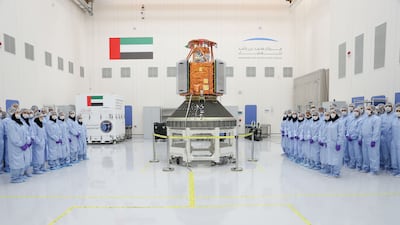Emirati engineers received the first signal from Sharjah’s first satellite on Tuesday.
The Sharjah Sat 1 nanosatellite was launched on a SpaceX Falcon 9 rocket on January 3 to study the Sun and space weather.
It has been placed in low-Earth orbit at an altitude of 550km and is equipped with sensors, cameras and communication devices to carry out its mission.
The Sharjah Academy for Astronomy, Space Sciences and Technology (SAASST) of the University of Sharjah is overseeing the project and received the first signal.
“The project engineers at SAASST were prepared to receive the first communication signal from the CubeSat after it reached its orbit around Earth,” the university said in a statement.
“The signal demonstrates the state of the satellite and its readiness to perform its mission after a successful deployment from the main spacecraft.”

More signals are expected that will help to measure the satellite’s health.
Nanosatellites are miniature satellites developed quickly and at a low cost compared with standard ones.
Sheikh Sultan bin Ahmed Al Qasimi, Deputy Ruler of Sharjah, said after the launch that he was proud of the Emirati engineers who worked on the satellite.
"We start our year by reaching space and we commend the efforts of the Sharjah Academy for Astronomy, Space Science and Technology and we are proud of the Emirati cadres of engineers and researchers who worked on the completion of Sharjah Sat 1," he said.
SpaceX offers rideshare missions that make it possible for space agencies, companies, students and researchers to send several payloads on one rocket.
Many Arab countries are taking advantage of these low launch costs, allowing them to develop their space programmes.
In the past five years, Bahrain, Kuwait and Jordan have launched satellites. Oman also built its first satellite but it was destroyed during a Virgin Orbit launch attempt this month.
Arabic names of UAE’s space missions and what they mean - in pictures














